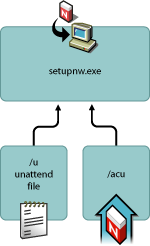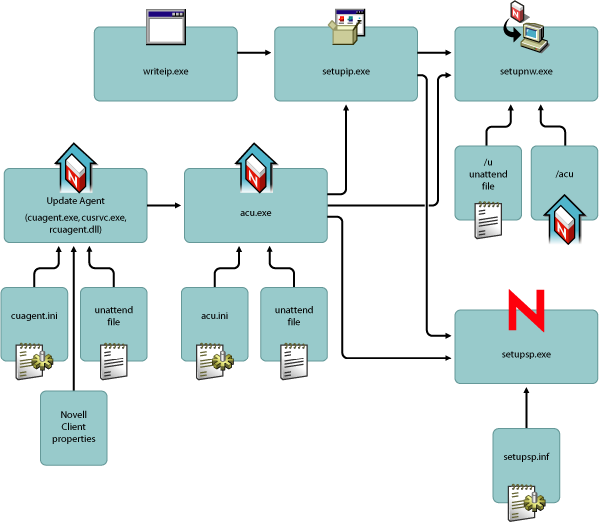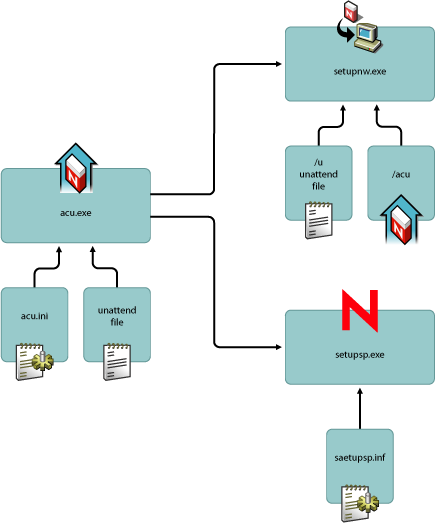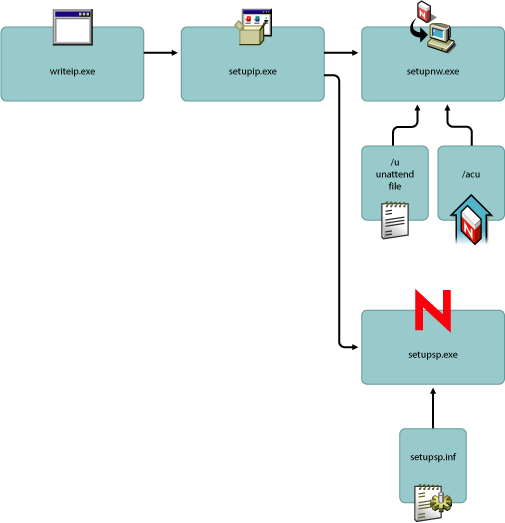4.1 Understanding Novell Client Installation and Update Options
Novell Client software has a robust set of tools that enable you to deploy client software upgrades and Support Packs to all workstations in your network without installing individually on each workstation. These tools can be combined in several different ways to create custom installation methods that suit your network and your workstation configurations.
The Novell Client can also be installed or updated from either a network server using a UNC path or mapped drive, or it can be installed or updated from a Web server using a URL. Depending on your network and the workstations that need to be updated, you might want to configure one or both of these installation methods. Using both of these methods is explained later in this section.
HINT:For more information about installing on one workstation, see Section 3.0, Installing the Novell Client on a Single Workstation.
A general understanding of all of the tools and how they work together can help you decide which tools are best suited for your needs. The following is an explanation of the various tools and configuration files that can be used to customize the installation or update of the Novell Client software.
-
Section 4.1.1, Understanding the Basic Novell Client Installation (setupnw.exe)
-
Section 4.1.2, Understanding Novell Client Support Pack Installation (setupsp.exe)
-
Section 4.1.3, Understanding Automatic Client Upgrade (acu.exe)
-
Section 4.1.4, Understanding Novell Client Install Manager (nciman.exe)
-
Section 4.1.5, Understanding Novell Client Web Install Utility (setupip.exe)
-
Section 4.1.6, Understanding the Novell Client Update Agent (cuagent.exe)
4.1.1 Understanding the Basic Novell Client Installation (setupnw.exe)
Novell Client software is installed by setupnw.exe.
Figure 4-1 Basic Novell Client Installation

The setupnw.exe installation process can be modified by two different command line switches:
-
/U: Applies client settings and modifies install behavior based on settings in a specified configuration (unattend) file created by Novell Client Install Manager (nciman.exe). For more information, see Creating the Configuration File (Unattend File).
-
/ACU: Directs setupnw.exe to perform an upgrade of the currently installed client software only if the version to be installed is a later one.
/ACU and /U can be specified together at the command line.
4.1.2 Understanding Novell Client Support Pack Installation (setupsp.exe)
If workstations need to have only a specific Support Pack applied, use the Novell Client Support Pack installation utility (setupsp.exe). The Support Pack installs only a subset of client files and does not require a client version change. Support Pack Install Files can also be added to the Client Install Files (in an overlay manner) to allow the installation of both the client and the Support Pack in one step. For more information, see Installing Support Packs.
Figure 4-2 Support Pack Installation

Setupsp.exe can be customized by modifying the setupsp.inf file to specify Support Pack options, display options, and update options.
4.1.3 Understanding Automatic Client Upgrade (acu.exe)
The Automatic Client Upgrade utility (acu.exe) determines whether the client needs to be updated, allows you to specify several installation options, and allows you to uninstall unwanted components.
Figure 4-3 Automatic Client Upgrade Process

ACU's actions are determined by acu.ini, a text file that can be modified to change the behavior of acu.exe. ACU can also accept information from a configuration (unattend) file that is created by Novell Client Install Manager (nciman.exe). For more information, see Creating the Configuration File (Unattend File).
IMPORTANT:If you use a configuration (unattend) file to configure Novell Client with acu.exe, you must change the Use=No to Use=Yes and you must specify the name of the configuration file and the path to it in the File=\\server\volume\path\file. Both of these changes are made in the [UNATTENDFILE] section of the acu.ini file.
ACU can be launched from within the login script. ACU determines if a complete update of the Novell Client (setupnw.exe) or a Support Pack (setupsp.exe) is required and then launches the appropriate utility. Each utility then can use the associated configuration files to complete a customized installation. Launching ACU from the login script saves network bandwidth during login because the Setup utility is run only if the client needs to be updated.
4.1.4 Understanding Novell Client Install Manager (nciman.exe)
Novell Client Install Manager (nciman.exe) generates a configuration (unattend) file that sets client settings and dictates client installation behavior. Novell Client Install Manager is located in the admin folder in the directory where you unzipped the download file. This file can be used by the Automatic Client Upgrade utility (acu.exe) or by the Client install utility (setupnw.exe). You can create several different configuration files for different groups of workstations if necessary and specify their use by indicating a path to the desired configuration file in the acu.ini file or at the command line. For more information, see Creating the Configuration File (Unattend File).
4.1.5 Understanding Novell Client Web Install Utility (setupip.exe)
The Novell Client Web Install utility simplifies the creation of a Web-based installation. Setupip.exe is a utility that downloads the Novell Client install files from a Web server and launches the Novell Client install.
Figure 4-4 Novell Client Web Install Utility

Setupip.exe is created by running writeip.exe. It can configure up to five different addresses that the client can be installed from as well as indicate whether to launch a full client installation (setupnw.exe) or to launch a Support Pack installation (setupsp.exe). It can also be configured to accept settings from a configuration (unattend) file.
Setupip.exe can also launch acu.exe to determine if a complete installation or a Support Pack installation needs to be launched.
Figure 4-5 Novell Client Web Install Affected by ACU

4.1.6 Understanding the Novell Client Update Agent (cuagent.exe)
The Novell Client Update Agent provides a workstation-initiated (manual or automatic) update of the Novell Client software. It launches acu.exe from a specified location. The Update Agent can be run manually from the Red N menu or it can be configured to automatically check for updates at specified intervals.
Figure 4-6 The Novell Client Installation Update Agent

If it is configured to check automatically, each time a user logs in to the network, it runs and determines if the preconfigured number of days have elapsed since the last upgrade check and then checks the specified location for a newer version of the client or for Support Pack updates. If a newer version or Support Pack is found, ACU then launches the appropriate installation process.
NOTE:Before workstations can check to see if updates are available, the Update Agent must be configured during a software installation or by using Automatic Client Upgrade (ACU). Or, you can configure the Update Agent on each machine locally through the Novell Client property pages.
The Update Agent is configured by modifying the Update Agent property page settings or (optionally) the cuagent.ini file. Because the Update Agent launches ACU, which in turn launches either setupnw.exe or setupsp.exe, all of the configuration changes made to these subsequent utilities are used in the same way they would be when not running the Update Agent. For more information, see Setting Up the Novell Client Update Agent.